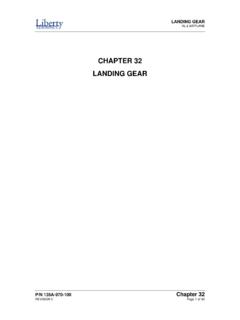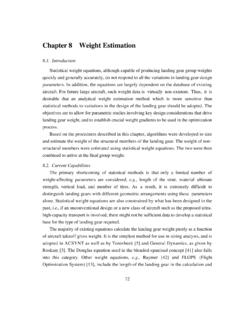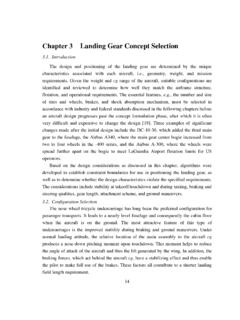Transcription of Failure to Follow Procedures Landing Gear Failure Course
1 Failure to Follow Procedures Landing gear Failure Course Narrative: Slide 1 Landing gear failures: What causes them? Every year, we see a number of these events. The FAA Safety Team, called the FAASTeam, has analyzed the accident data in an effort to understand what is happening and why. This Course will help you understand the findings and the role each Aviation Maintenance Technician has in the prevention of Landing gear failures. Slide 2 The FAASTeam analyzed data, from defensible sources, to isolate those caused by maintenance related issues. Slide 3 Data from January 1, 2002, through December 31, 2006 was analyzed. 1,878 events involving Landing gear Failure were identified. Of these events, 1,777 were attributed to causes other than maintenance. 101 or were identified as having maintenance related issues as a causal factor. Slide 4 Further analysis allows a categorization of the maintenance causal factors into 4 general areas. Undetermined, improper maintenance, Failure to Follow Procedures , and inadequate maintenance.
2 The 54 events in the undetermined category were largely placed there due to poor event documentation and data availability. The FAASTeam has submitted recommendations for improvement to accident and incident investigation documentation. It is also noteworthy that human factors were cited as a contributing factor in many events. Slide 5 Of the 47 maintenance related errors where causal factor could be determined, over 70% were attributed to improper maintenance. 15% were Failure to Follow procedure events, or just over 85% of the Landing gear Failure events were attributed to maintenance personnel. Some events identified as inadequate maintenance could not necessarily be attributed directly to maintenance personnel. Slide 6 Maintenance related Landing gear failures occur regardless of the type of aircraft operations being conducted or the make and model of aircraft being used. However data does indicate that general aviation operations and aircraft do have a higher occurrence of Landing gear failures.
3 Slide 7 Aircraft accident and incident events occur regularly and can attract a lot of attention. Remember this one? On September 21, 2005, after take-off, the nose Landing gear on this Airbus A-320 turned 90 degrees to the left and the Landing gear would not retract. The aircraft had to return to the airport. This event was broadcast live on almost every media network in the United States. Upon Landing , the nose gear skidded along the runway until the aircraft came to a full stop. Luckily, there were no injuries. For those of us who saw this event unfold on the news or learned about it later, how many actually found out what happened? How many of us actually learned the nuts and bolts of how this Failure occurred? We ll touch on this later in the Course . Slide 8 Fortunately, crew and passengers are not typically injured in Landing gear failures, but these events are costly in terms of damage to aircraft. This event was a result of a component Failure causing the right main gear to collapse.
4 Slide 9 Imagine you were the last AMT to work on this aircraft s Landing gear system. Upon returning to the airport, the pilot selects gear down, but fails to get a gear safe indication on the nose gear . The pilot cycles the gear over and over again. The pilot calls you on the radio, then does a fly-by so you can make an evaluation. You tell the pilot both main Landing gears are down, but the nose gear is still in the well. Your mind races: What could have happened? Slide 10 Keep thinking about what might have happened. In the meantime, let s talk about improper maintenance and inadequate maintenance. When a specific procedure error could be identified, that event was associated with Failure to Follow Procedures . Can we associate improper maintenance with Failure to Follow Procedures ? Yes! Can we associate inadequate maintenance with Failure to Follow Procedures ? Yes! So, when you put this information together, we might logically conclude that virtually ALL maintenance failures are associated with Failure to Follow Procedures !
5 Slide 11 Now, back to the plane with the Landing gear problem. After all attempts fail, you watch helplessly as the pilot executes a wheels-up Landing on the grass. Slide 12 While there is a definition for inspection found in the Federal Aviation Regulations, where can you find the official definition for improper maintenance? There is no current definition. So, how should we apply the term with respect to this Course ? Simply, a maintenance error. Slide 13 While there is a definition for inspection found in the regulations there is not currently found a definition for improper inspection . For the purposed of this Course we will think in terms of inspection omission or error. Slide 14 Where do you find instructions to install components? Manufacturer s Maintenance Manuals and/or other methods, techniques and practices acceptable to the Administrator. There is no current definition for the term Improper Installation. So, for the purposes of this Course we will think in terms of installation omission or error.
6 The FAASTeam has submitted a recommended definitions for improper maintenance, improper inspection and improper installation to FAA Headquarters for consideration Slide 15 The next series of slides reviews an event involving a Piper PA-34 that experienced a series of Landing gear failures. If this aircraft looks familiar, it is because you saw it earlier, wheels-up in the grass. The aircraft sustained substantial damage as a result. The aircraft was repaired, and returned to service on April 5, 2008. This picture was taken on April 8, 2008, three days after the approval to return to service. This time, the nose gear collapsed, after Landing , causing substantial damage to the propellers, engines, nose gear doors and chin of the aircraft. Slide 16 Two technicians, with the aid of a forklift, prepare to remove the aircraft from the runway. Slide 17 The nose gear is manually extended and secured, using a piece of angle iron, clamped to the nose gear linkage. A tow bar is attached to the nose gear and the technicians start to tow the aircraft back to the hangar.
7 Slide 18 They had not traveled more than a few feet with the left main Landing gear collapsed, causing additional damage to the left wing, left aileron, and stabilator tip. Slide 19 Here, the right main Landing gear is positively secured prior to raising the aircraft and securing the left main Landing gear . Note the green belly panels. These panels were just replaced as a result of the wheels-up Landing we saw earlier. Slide 20 Upon inspection we see a broken down lock link assembly that was the cause of the nose gear collapse. Slide 21 This is that same down lock assembly removed from the aircraft. Note the broken rod end and the bent attachment hardware . What are these parts telling us? Remember, this aircraft has now experienced a series of Landing gear Failure events. Slide 22 The FAA issued Airworthiness Directive 2005-13-16 to address this problem. It is the result of service difficulty reports related to the collapse or involuntary retraction of the nose Landing gear .
8 The actions specified in this Airworthiness Directive , or AD, are intended to detect, correct and prevent Failure in certain components of the nose Landing gear , lack of cleanliness of the nose Landing gear due to inadequate maintenance, or lack of lubricant in the nose Landing gear or its components. Failure of the nose Landing gear could lead to loss of control of the airplane during take-off, Landing or taxi operations. This AD was complied with on this aircraft in June 2007, yet still the aircraft experienced a number of Landing gear Failure events. Slide 23 This is a page from the Piper Service Bulletin number 1123A. It shows an area of concern in the vicinity of the nose Landing gear . Specific instructions are given on how and where to inspect for any relative motion between the riveted components. Slide 24 This is the area of concern depicted in the Piper Service Bulletin. When this picture was taken, the weight of the aircraft was on jacks. Note the relative spacing between the two structural components highlighted by the arrow.
9 Slide 25 Now look at the same area, only now the weight of the aircraft is on the wheels. Note the relative spacing that now exists between these two structural components. This is the exact unsafe condition the AD and Service Bulletin addressed, and it was this unsafe condition that contributed to the Landing gear failures experienced by this aircraft. Had the Procedures contained in the AD and service bulletin been followed, this problem could have been found in 2007, and the subsequent Landing gear failures never would have happened. Maintenance personnel were responsible for these Landing gear failures because they failed to Follow the Procedures spelled out in the technical data. At this point we have uncovered the technical nuts and bolts of why this aircraft experienced so many Landing gear failures. Failure to Follow Procedures allowed an unsafe condition to persist that led to multiple Landing gear Failure events before the real problem could be fixed. Slide 26 Failure to Follow Procedures is the number one mistake Aircraft Maintenance Technicians make.
10 What Procedures do we miss? When we deviate from or skip Procedures contained in the technical data approved or accepted by the FAA we are guilty to Follow Procedures . Slide 27 The Landing gear Failure data analysis yielded no discernable trends. The nuts and bolts of each Failure were different. No two were the same. What the data did show was that some form of human factor error was associated with all of the Landing gear Failure events. Slide 28 Human factors are the root cause of Failure to Follow procedure mistakes. When one looks at all the mistakes we have or can make it would be impractical to think we could learn from each individual mistake. However, it is vital that we learn from our mistakes in general. One way would be to learn to associate the mistakes we make with a human factor and/or environmental circumstance that enabled us to make the mistake. Slide 29 The 5 years of event data used for this Course shows 33 maintenance related Landing gear Failure events were associated with improper maintenance.



















